Snowflake Bundle
Who are Snowflake's Ideal Customers?
In today's data-driven world, understanding the Snowflake SWOT Analysis is just the beginning. Snowflake's journey, marked by a historic IPO, reflects a paradigm shift in how businesses manage and leverage data. But who exactly is driving this demand for its cloud data platform?
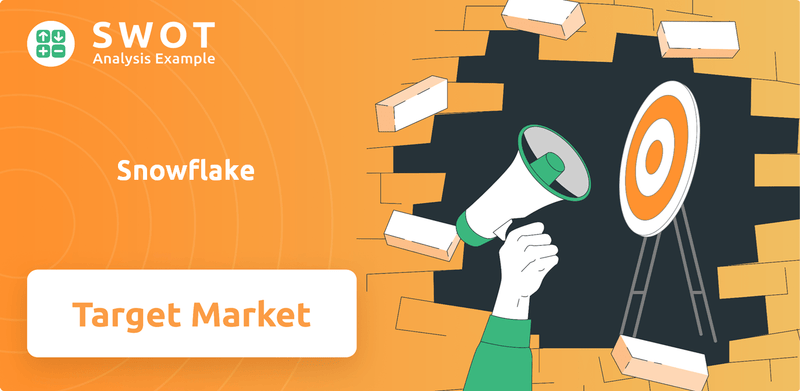
This analysis delves into the intricate details of Snowflake's customer demographics and target market, exploring the evolution of its Snowflake target market from early adopters to a diverse Snowflake audience. We'll examine the Snowflake company's strategic shifts, its customer acquisition strategy, and the factors that contribute to its continued success. Understanding the Snowflake users and their evolving needs is crucial for anyone looking to capitalize on the data revolution.
Who Are Snowflake’s Main Customers?
The primary focus of the Growth Strategy of Snowflake is the Business-to-Business (B2B) sector, targeting a wide array of organizations rather than individual consumers. The core of its customer demographics consists of businesses of various sizes, including both rapidly expanding startups and well-established corporations, spanning nearly every industry. These businesses leverage Snowflake's platform for critical data operations, such as customer analytics, operational efficiency, fraud detection, supply chain optimization, and product development.
Key customer segments for the Snowflake company include those in financial services, healthcare, retail, media and entertainment, technology, and manufacturing. These sectors rely on the Snowflake data platform to handle large volumes of data, complex integration needs, and the desire to democratize data access across their organizations. The company's ability to serve these diverse needs has fueled its growth and solidified its position in the market.
While specific demographic details like age or income levels aren't applicable to its B2B customers, their characteristics are defined by their data maturity, cloud adoption strategies, and the scale of their data challenges. Companies that have significant data volumes, complex data integration needs, or a desire to democratize data access across their organizations are prime candidates. The company has seen substantial growth in its enterprise customer base, with 691 customers generating over $1 million in product revenue in Q4 FY24, an increase from 402 in Q4 FY23. This demonstrates that larger enterprises represent a significant and growing share of the company's revenue.
The Snowflake target market is primarily composed of B2B clients. These include a mix of startups and large corporations. Key industries include financial services, healthcare, and technology.
Customers often have significant data volumes and complex integration needs. They seek to democratize data access across their organizations. Cloud adoption strategies and data maturity are key factors.
The company added 163 net new customers in Q4 FY24. The total customer base reached 9,487. A significant number of customers generate over $1 million in product revenue.
Early adopters were often tech-forward companies. As cloud adoption increased, the company expanded to include more traditional industries. Data is increasingly recognized as a strategic asset across all sectors.
The main Snowflake users are in industries such as financial services, healthcare, and technology. These sectors use the platform for critical data operations. The company focuses on businesses with large data volumes and complex needs.
- Financial Services
- Healthcare
- Retail
- Media and Entertainment
- Technology
- Manufacturing
Snowflake SWOT Analysis
- Complete SWOT Breakdown
- Fully Customizable
- Editable in Excel & Word
- Professional Formatting
- Investor-Ready Format
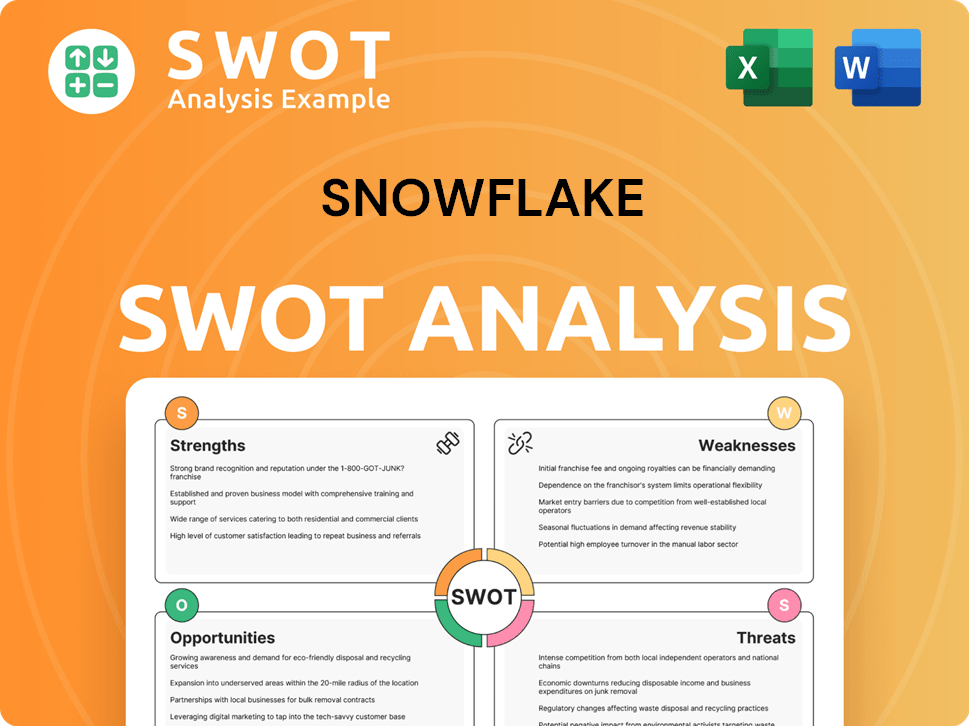
What Do Snowflake’s Customers Want?
The core of the Snowflake company's customer base is driven by the need for effective data management and analytical capabilities. Their primary goals include extracting deeper insights from their data, boosting operational efficiency, and fostering innovation. These needs shape their purchasing decisions and the criteria they use to evaluate the platform.
Customers are often looking to break down data silos and enable broader data access across their organizations. They seek solutions to common challenges like slow query performance and the high costs associated with traditional data warehouses. The evolution of the platform reflects these needs, incorporating features that cater to advanced data science and application building.
The shift towards cloud-native architectures and the growing importance of AI and machine learning significantly influence the development of the Snowflake data platform. The company tailors its marketing efforts by emphasizing its platform's ability to solve specific industry challenges, showcasing customer success stories, and offering flexible pricing models.
Customers prioritize platforms that deliver high performance and can scale easily to handle growing data volumes. The ability to independently scale storage and compute resources is a key advantage.
The platform's user-friendliness and ease of integration with existing systems are crucial for adoption. Simple interfaces and intuitive tools are highly valued.
Customers are always looking for solutions that offer a good return on investment. Transparent and flexible pricing models that align with usage patterns are essential.
Robust security features and compliance with industry standards are non-negotiable. Data protection and privacy are top priorities for all organizations.
The ability to handle diverse data types and support various workloads, including real-time data processing and advanced analytics, is a key requirement.
Seamless integration with existing data sources and the ability to provide broad data access across the organization are critical for achieving business goals.
The Snowflake target market is broad, encompassing various industries and company sizes. They cater to organizations that need to manage and analyze large datasets efficiently. The platform's flexible architecture and pricing models make it suitable for both small startups and large enterprises. For example, as of Q1 2024, Snowflake users included over 9,900 customers, with a significant portion being large enterprises. Understanding the Snowflake customer profile by industry helps in tailoring solutions and marketing efforts. The company's customer acquisition strategy focuses on demonstrating value through case studies and industry-specific solutions. For more insights into the company's financial performance, you can read about the Owners & Shareholders of Snowflake.
The core needs of Snowflake's audience revolve around improving data-driven decision-making and operational efficiency. The platform addresses these needs by providing a scalable, secure, and user-friendly data management solution.
- Efficient data warehousing and analytics.
- Scalability to handle growing data volumes.
- Cost-effective data storage and processing.
- Enhanced data security and compliance.
- Support for diverse data types and workloads.
Snowflake PESTLE Analysis
- Covers All 6 PESTLE Categories
- No Research Needed – Save Hours of Work
- Built by Experts, Trusted by Consultants
- Instant Download, Ready to Use
- 100% Editable, Fully Customizable
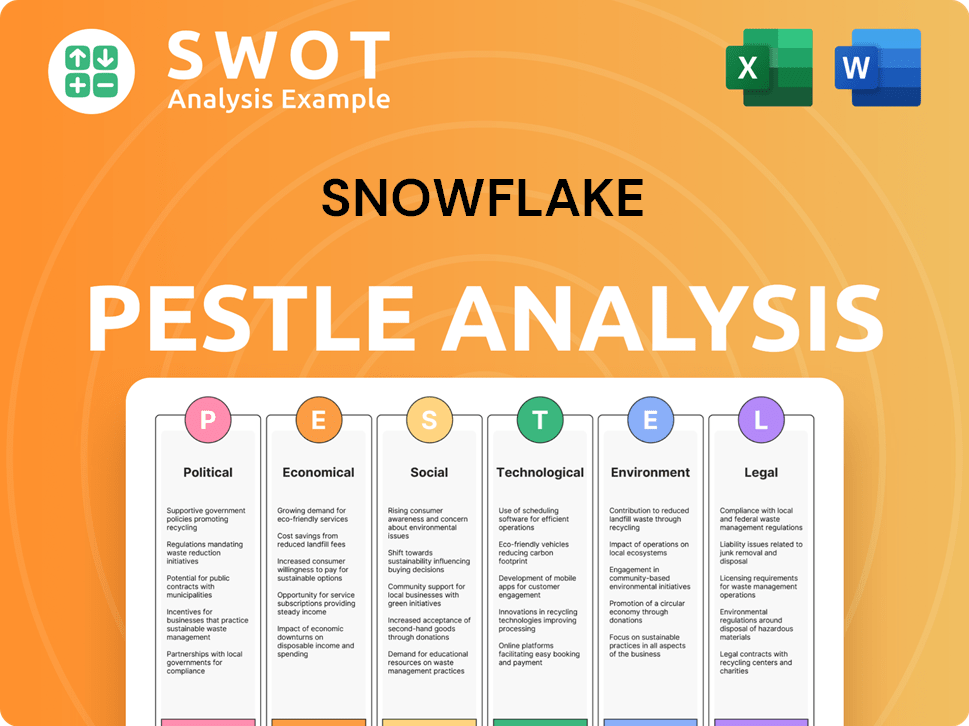
Where does Snowflake operate?
The geographical market presence of the company is substantial, with a strong focus on North America, Europe, and the Asia-Pacific region. North America, particularly the United States, represents its largest market, holding a significant portion of its revenue and customer base. The company's expansion strategies consistently emphasize deepening its footprint in key international markets, adapting to varied regional needs and regulations.
Differences in the company's customer demographics and preferences across these regions are linked to varying cloud adoption levels, data privacy regulations, and industry-specific data maturity. The company localizes its offerings by ensuring compliance with regional data governance requirements and by building out local sales and support teams to better understand and serve the unique needs of businesses in different countries. For example, its data residency options allow customers to choose the geographic location of their data storage, addressing specific regulatory or compliance needs.
Recent expansions have included strengthening its presence in regions like Japan and Australia, reflecting the growing demand for cloud data solutions in these areas. The geographic distribution of sales continues to be concentrated in developed economies with high cloud infrastructure adoption rates. Understanding the company's Revenue Streams & Business Model of Snowflake can provide further insights into its global market strategy.
North America is the company's primary market, accounting for a substantial share of its revenue. The United States alone significantly contributes to its overall customer base and revenue figures. The company has strong brand recognition and market share within the cloud data platform space in the US.
Europe represents a key market for the company, with a growing customer base. The company has been adapting to stringent data privacy regulations like GDPR. It focuses on compliance and localization to meet the specific needs of European businesses.
The Asia-Pacific region is a growing market for the company, with increasing demand for cloud data solutions. The company is expanding its presence in countries like Japan and Australia. They are focusing on building local sales and support teams to better serve the unique needs of businesses in this region.
The company offers data residency options, allowing customers to choose the geographic location of their data storage. This feature helps address specific regulatory or compliance needs, particularly in regions with strict data privacy laws. This is a key part of their strategy to attract and retain customers globally.
Snowflake Business Model Canvas
- Complete 9-Block Business Model Canvas
- Effortlessly Communicate Your Business Strategy
- Investor-Ready BMC Format
- 100% Editable and Customizable
- Clear and Structured Layout
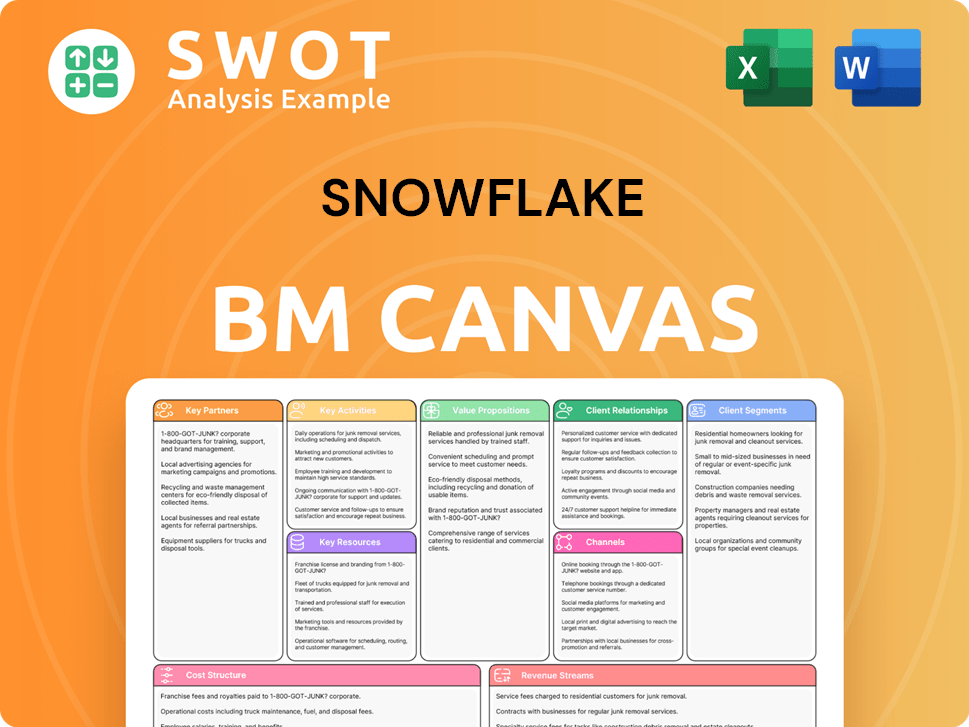
How Does Snowflake Win & Keep Customers?
Understanding the customer acquisition and retention strategies of a company like Snowflake is crucial for grasping its market position and growth trajectory. Snowflake, a leading data platform, employs a multifaceted approach to attract and retain its customer base. This involves a combination of digital marketing, direct sales, strategic partnerships, and a strong focus on customer success.
The company's customer acquisition strategy is designed to reach a broad audience, from small businesses to large enterprises. Key components include content marketing, search engine optimization (SEO), and targeted online advertising. Moreover, Snowflake leverages a direct sales force, particularly for engaging with enterprise-level clients, often using a land-and-expand strategy. This approach involves initially securing a presence within an organization and then expanding its footprint as the customer's needs evolve.
Snowflake's success hinges on its ability to retain customers and foster long-term relationships. The company prioritizes customer success through robust support, professional services, and a vibrant user community. A consumption-based pricing model aligns costs with usage, encouraging customer trust and flexibility. These strategies contribute to Snowflake's strong net revenue retention rate, indicating its success in retaining and growing its existing customer base.
Snowflake uses digital marketing, including content marketing (whitepapers, case studies, webinars) and SEO, to attract potential customers. This helps improve online visibility and reach. Effective SEO strategies are essential for driving organic traffic and leads to the company's website, where potential customers can learn more about the data platform.
The company relies heavily on its direct sales force, especially for enterprise-level clients. A land-and-expand strategy is frequently employed to establish a foothold within an organization and then grow as customer needs increase. This approach allows for personalized engagement and tailored solutions, contributing to higher customer lifetime value.
Collaborations with major cloud providers (AWS, Azure, Google Cloud) and technology partners are vital. These partnerships extend Snowflake's reach and integrate its platform into broader solutions. These partnerships are crucial for expanding the Snowflake users base and providing comprehensive data solutions.
Customer success is a priority, with robust support, professional services, and a vibrant user community. The consumption-based pricing model aligns costs with usage, promoting trust and flexibility. These efforts help ensure high customer satisfaction and retention rates.
Snowflake's focus on customer retention is evident in its financial performance. The net revenue retention rate was 131% in Q4 FY24. This demonstrates that existing customers are increasing their spending with Snowflake. The company's ability to retain and expand its customer base is a key factor in its continued growth and success.
- The Snowflake customer profile by industry includes sectors like finance, healthcare, and technology.
- Snowflake customer demographics by company size range from small businesses to large enterprises.
- Snowflake market segmentation targets various use cases, such as data warehousing, data lakes, and data engineering.
- The company's focus on the "Data Cloud" fosters data sharing and collaboration among customers, increasing stickiness and lifetime value.
For more in-depth analysis of the Snowflake company and its market approach, consider exploring the Marketing Strategy of Snowflake.
Snowflake Porter's Five Forces Analysis
- Covers All 5 Competitive Forces in Detail
- Structured for Consultants, Students, and Founders
- 100% Editable in Microsoft Word & Excel
- Instant Digital Download – Use Immediately
- Compatible with Mac & PC – Fully Unlocked
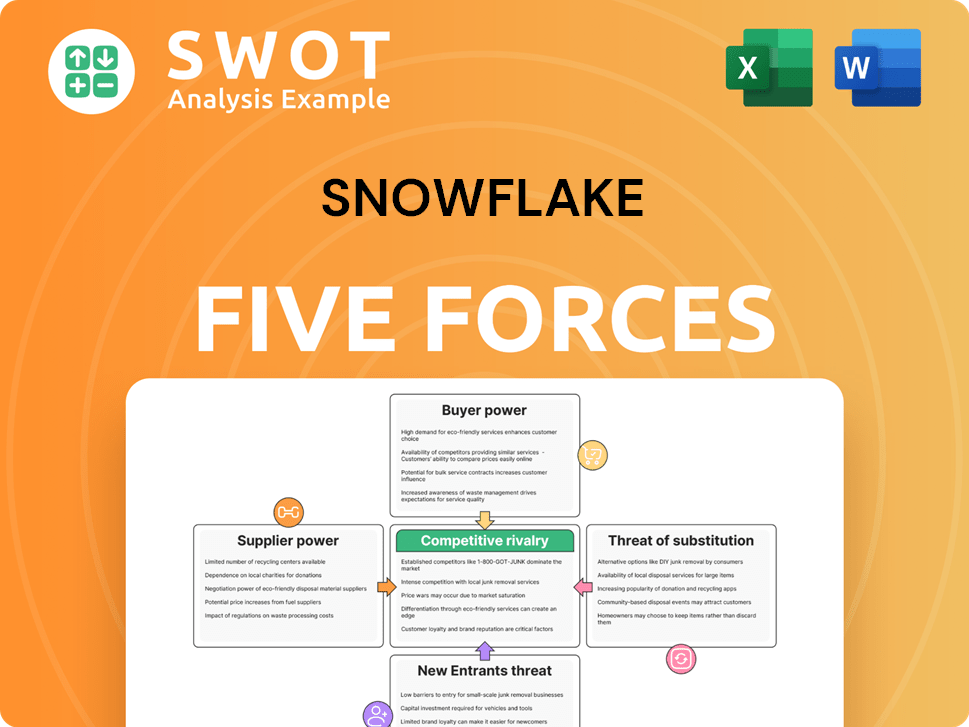
Related Blogs
- What are Mission Vision & Core Values of Snowflake Company?
- What is Competitive Landscape of Snowflake Company?
- What is Growth Strategy and Future Prospects of Snowflake Company?
- How Does Snowflake Company Work?
- What is Sales and Marketing Strategy of Snowflake Company?
- What is Brief History of Snowflake Company?
- Who Owns Snowflake Company?
Disclaimer
All information, articles, and product details provided on this website are for general informational and educational purposes only. We do not claim any ownership over, nor do we intend to infringe upon, any trademarks, copyrights, logos, brand names, or other intellectual property mentioned or depicted on this site. Such intellectual property remains the property of its respective owners, and any references here are made solely for identification or informational purposes, without implying any affiliation, endorsement, or partnership.
We make no representations or warranties, express or implied, regarding the accuracy, completeness, or suitability of any content or products presented. Nothing on this website should be construed as legal, tax, investment, financial, medical, or other professional advice. In addition, no part of this site—including articles or product references—constitutes a solicitation, recommendation, endorsement, advertisement, or offer to buy or sell any securities, franchises, or other financial instruments, particularly in jurisdictions where such activity would be unlawful.
All content is of a general nature and may not address the specific circumstances of any individual or entity. It is not a substitute for professional advice or services. Any actions you take based on the information provided here are strictly at your own risk. You accept full responsibility for any decisions or outcomes arising from your use of this website and agree to release us from any liability in connection with your use of, or reliance upon, the content or products found herein.